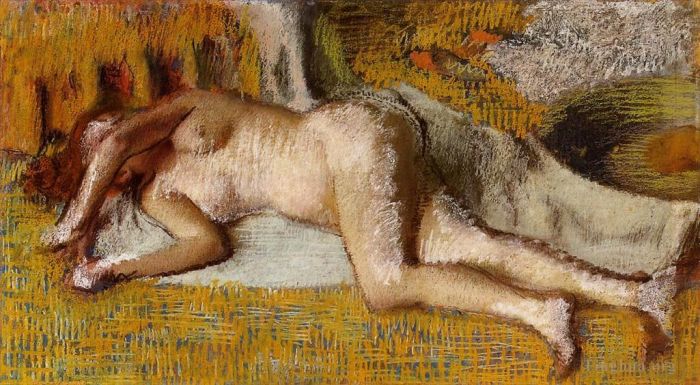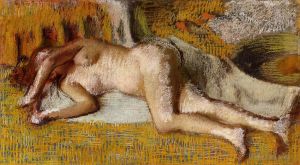After the Bath
Edgar Degas
- Price: Price on Request
- Art Type: Various Paintings
- Size:
- English Comments: 0
- International Comments: 0
- Creating Date:
- Introduction and Works of Edgar Degas >>
Keywords:
Bath
Work Overview
- After the Bath
Edgar Degas
Date: c.1885
Style: Impressionism
Genre: nude painting (nu)
Media: pastel
Like all the young people of his generation who wanted a career in art, Degas received a training based on drawing nude figures. Considered to be the most difficult and the most instructive exercise, l'académie – the study of the nude figure that generated many of the drawings presented here – was taught in the studios where Degas started his training, those of Barrias (1822-1907) and Lamothe (1822-1869), both disciples of Ingres.
Artists at that time learned the art of painting the nude by copying the sculptures of classical antiquity and the old masters, or by working from a life model.
Firstly at the Louvre and the Cabinet des Estampes in the Bibliothèque Nationale, then during an extended trip around Italy from 1856 to 1859 when he visited the greatest Renaissance museums and monuments, Degas built up a great understanding of the painting of his illustrious predecessors that would accompany all of his stylistic evolutions, even the most avant-garde.
However, by looking to the past, Degas was not searching for a model to follow slavishly but rather a series of perspectives that would enable him to create his own style. It is this synthesis that explains the originality of Degas' compositions, even though these early paintings are in the great historical genre beloved by the academicians of the time.
Thus, Young Spartans Exercising, evokes Antiquity but mainly provides the artist with an opportunity to demonstrate his research into the human figure, if we are to believe the many studies he had produced earlier. The accuracy of his drawing certainly conforms to the teaching he had received, but the attention given to the gestures appears to be totally original.
- Copyright Statement:
All the reproduction of any forms about this work unauthorized by Singing Palette including images, texts and so on will be deemed to be violating the Copyright Laws.
To cite this webpage, please link back here.
- >> English Comments
- >> Chinese Comments
- >> French Comments
- >> German Comments
- >>Report
- The Dance Class
- Portrait of the Painter Henri Michel Levy
- The Rehearsal
- The Rape
- Edmond and Therese Morbilli
- Before the Race2
- Ballet Rehearsal
- At the Milliner s
- Singer with a glove (Café Singer)
- Head of a Young Woman
- At the Races Before the Start
- Four Dancers
- At the Milliners 2
- The Ballet Class
- The Star
- Woman Ironing 1884
- At the Races in the Countryside (A Carriage at the Races)
- Portrait after a Costume Ball Portrait of Madame DietzMonnin
- Beach Scene
- A Roman Beggar Woman
- A Carriage at the Races
- Degas in a Green Jacket
- Henri De Gas and His Neice Lucie Degas
- Dancer At The Photographers
- Ballerina and Lady with a Fan
- Self Portrait
- At the Races the Start
- At the Milliners
- Achille De Gas in the Uniform of a Cadet
- The Millinery Shop
- Interior aka The Rape
- In a Café (Glass of Absinthe or The Absinthe Drinker)
- Diego Martelli
- Cotton exchange
- Ballet at the Paris Opera
- Edmond Duranty
- The Star (Ballet or Dancer on Stage)
- Hortense Valpin
- The Dancing Class
- Dancers in Pink
- The Bellelli Family (Family Portrait)
- At the Milliners 3
- At the Races
- Cafe concert
- Portrait of Mary Cassatt
- The Parade (Race Horses in front of the Tribunes)
- Woman ironing
- Ballet Class
- Emma Dobigny
- CAFÉ CONCERT AT LES AMBASSADEURS
- The Duke and Duchess Morbilli
- The Rehearsal of the Ballet Onstage
- Dancer at the Barre circa 1880
- At the Mirror
- After the Bath
- Study of Gentile bellini 1854
- After the Bath
- Before the Rehearsal 1880
- After The Bath
- The Tub
- After The Bath 1884
- Woman Combing Her Hair
- At the Ballet
- The Dance Examination
- Woman At Her Toilet
- After the Bath Woman Drying Herself
- Seated Dancer Adjusting Her Shoes









 Singing Palette
Singing Palette